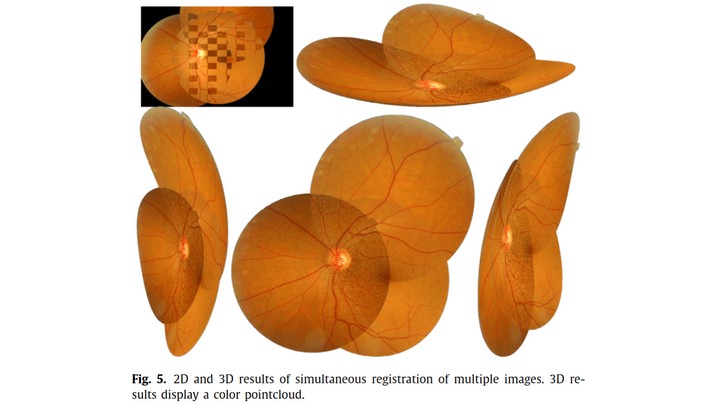Retinal Image Registration as a Tool for Supporting Clinical Applications

Abstract
This is an article with experiments for clinical applications of the REMPE framework. The REMPE framework description can be found in this publication.
Background and Objective: The study of small vessels allows for the analysis and diagnosis of diseases with strong vasculopathy. This type of vessels can be observed non-invasively in the retina via fundoscopy. The analysis of these vessels can be facilitated by applications built upon Retinal Image Registration (RIR), such as mosaicing, Super Resolution (SR) or eye shape estimation. RIR is challenging due to possible changes in the retina across time, the utilization of diverse acquisition devices with varying properties, or the curved shape of the retina.
Methods: We employ the Retinal Image Registration through Eye Modelling and Pose Estimation (REMPE) framework, which simultaneously estimates the cameras’ relative poses, as well as eye shape and orientation to develop RIR applications and to study their effectiveness.
Results: We assess quantitatively the suitability of the REMPE framework towards achieving SR and eye shape estimation. Additionally, we provide indicative results demonstrating qualitatively its usefulness in the context of longitudinal studies, mosaicing, and multiple image registration. Besides the improvement over registration accuracy, demonstrated via registration applications, the most important novelty presented in this work is the eye shape estimation and the generation of 3D point meshes. This has the potential for allowing clinicians to perform measurements on 3D representations of the eye, instead of doing so in 2D images that contain distortions induced because of the projection on the image space.
Conclusions: RIR is very effective in supporting applications such as SR, eye shape estimation, longitudinal studies, mosaicing and multiple image registration. Its improved registration accuracy compared to the state of the art translates directly in improved performance when supporting the aforementioned applications.